🔑 Key Takeaways
- Understand what a dado blade is and why it matters in woodworking
- Learn the difference between stacked and wobble dado sets
- Know how to choose the right dado blade for your table saw
- Follow safety practices when installing and operating dado blades
- Explore alternatives for making dado cuts
If you’re into woodworking, you’ve likely come across the term dado blade. But what exactly is it?
A dado blade is a specialized saw blade designed to cut wide grooves—also known as dadoes—into wood.
These grooves are commonly used to join two pieces of wood together cleanly and securely, especially in shelving, cabinetry, and furniture making.
Precision matters here. A poorly cut groove can lead to loose joints or uneven surfaces. Using a dado blade helps you create smooth, accurate cuts that elevate the strength and finish of your projects.
What is a Dado Blade?
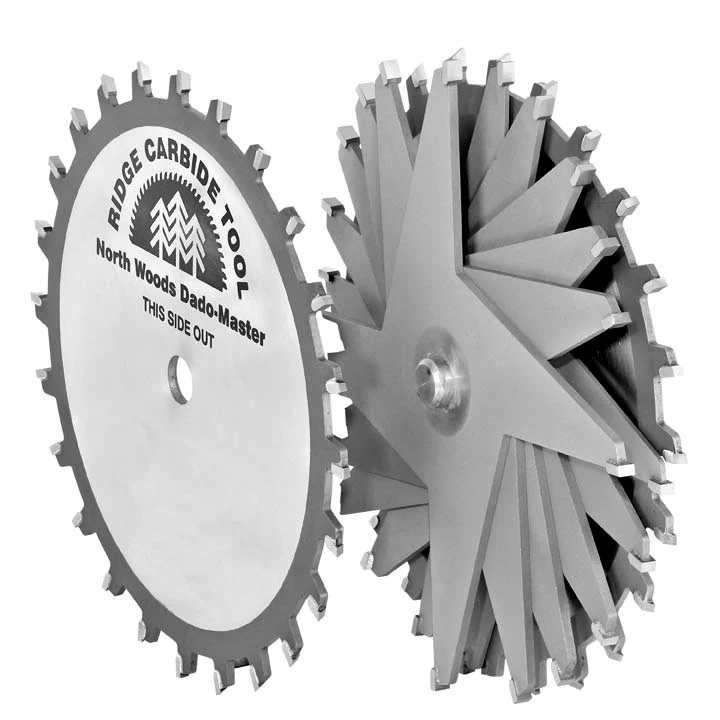
A dado blade is a circular saw blade or a set of blades designed to cut wide, flat-bottomed grooves in wood. Unlike a standard table saw blade that makes a thin kerf cut, a dado blade removes a wider section of material in a single pass.
There are two main types: stacked dado sets and wobble blades. A stacked set includes two outer blades and a series of inner chippers, which you can combine to create the exact groove width you need. Wobble blades, on the other hand, spin at an angle to produce an adjustable-width cut.
These blades are typically used with a table saw and require a throat plate wide enough to accommodate the blade setup. The primary goal is to produce accurate, clean grooves that fit perfectly with corresponding pieces—something traditional blades just can’t do efficiently.
Common Uses in Woodworking
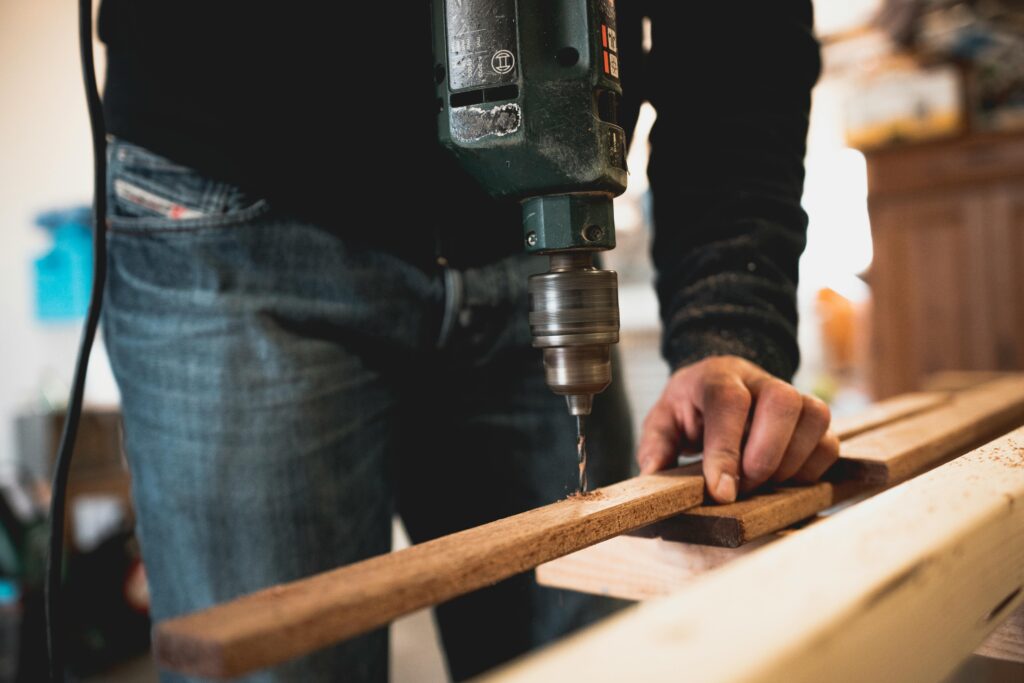
Dado blades are incredibly versatile and widely used across a variety of woodworking projects. One of their most common applications is in shelving—cutting dadoes along the side panels allows shelves to slide in snugly and sit flush without visible fasteners.
Another popular use is in creating cabinetry joints, like dado or rabbet joints, which provide a strong, hidden connection between two boards. These joints are especially helpful in box construction, drawer assemblies, and bookcases.
Woodworkers also use dado blades to make tenon shoulders, drawer bottoms, and even custom sliding panels. Essentially, any project that requires a secure, flush-fitting joint will benefit from the clean, precise grooves that dado blades produce. Whether you’re building furniture, fixtures, or organizing systems, a dado blade is a must-have in your toolkit.
🔧 Types of Dado Blades
1. Stacked Dado Blades
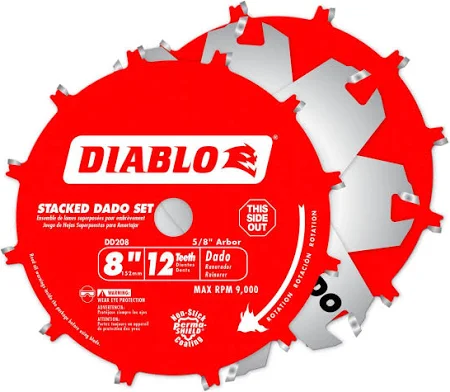
Stacked dado blades are the most common and preferred type for precision woodworking. These sets consist of two outer blades (also called cutters) and a series of inner chippers that can be added or removed to adjust the overall cutting width.
To fine-tune the groove even more, shim washers are used between the blades. This modular setup allows you to achieve cut widths ranging from 1/4 inch up to 13/16 inch or more, depending on the set.
The outer blades usually have ATB (Alternate Top Bevel) or FTG (Flat Top Grind) tooth configurations, which help produce clean edges and flat-bottom grooves. The chippers have fewer teeth but do the heavy lifting in clearing out the material.
Why choose stacked dado blades?
Because they offer precision, adjustability, and cleaner cuts, making them ideal for cabinetry, drawer boxes, bookshelves, and fine joinery work. They’re also less likely to produce vibration, which translates to smoother results.
If you’re aiming for high-quality, repeatable cuts with a variety of material types and thicknesses, a stacked dado set is the way to go.
2. Wobble Dado Blades
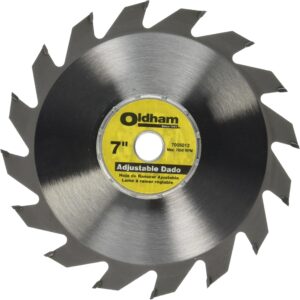
Wobble dado blades offer a more affordable, simplified alternative to stacked sets. Instead of multiple components, this blade is a single piece mounted on an eccentric spindle, causing it to “wobble” side to side as it spins. This sideways motion carves out a wide, rounded groove, and the width of the dado is adjusted by changing the angle of the blade on its arbor.
While wobble blades are generally easier to set up and less expensive, they come with some trade-offs. The grooves they produce often have a slightly concave bottom, which may not be ideal for projects requiring flat, tight-fitting joints. Wobble blades can also cause more vibration, which may lead to less precise cuts or added wear on your table saw.
That said, wobble blades can be useful for quick cuts, non-critical joinery, or when you’re working on a budget. They’re best suited for hobbyists or DIYers who need a versatile blade without investing in a full stacked set.
In short: wobble blades are simple and affordable, but stacked dado blades win when it comes to quality and control.
🪛 Choosing the Right Dado Blade Set
When you’re shopping for a dado blade set, it’s not just about price—it’s about finding the right fit for your tools, your projects, and your long-term goals in woodworking. Here are five key factors you should consider before making a purchase:
1. Blade Size and Compatibility
First, check your table saw’s manual to confirm it supports dado blades. Most dado sets are 8-inch in diameter, which is compatible with many contractor and cabinet saws. However, jobsite saws or compact table saws might not support dado blades at all. Also, confirm the arbor size—most sets require a 5/8-inch arbor.
2. Material and Build Quality
Look for dado blades with carbide-tipped teeth. These offer superior durability, sharper edges, and better performance, especially if you’re cutting through hardwood or plywood. High-quality materials also help minimize vibration and extend the blade’s lifespan.
3. Tooth Count and Configuration
The number of teeth on the outer blades can influence how clean your cuts are. More teeth typically mean smoother edges, especially in delicate materials like veneer plywood. Tooth configurations like ATB (Alternate Top Bevel) and FTG (Flat Top Grind) also affect how well the blade scores the wood and clears material.
4. Width Adjustability
A good dado set should let you cut a variety of groove widths, ideally ranging from 1/4 inch to 13/16 inch. Sets that include multiple chippers and shims give you more precision and flexibility for different joinery needs.
5. Brand Reputation and Reviews
Stick with trusted brands like Freud, DEWALT, or Oshlun. Check reviews to see how blades perform in real-world settings—look for feedback on cut quality, ease of setup, and longevity before you buy.
🏆 Top Recommended Dado Blade Sets
1. Freud SD508 Super Dado Set
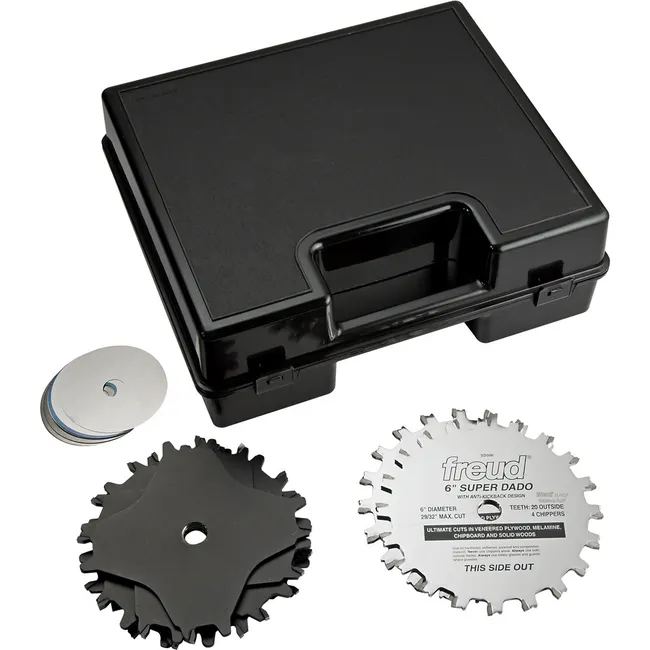
The Freud SD508 Super Dado Set is a premium, high-performance choice for serious woodworkers. This 8-inch stacked set includes two outer blades, six chippers, and a set of shims for micro-adjustments—allowing you to cut grooves from 1/4″ to 29/32″ with exceptional precision. Each blade features carbide-tipped teeth and a laser-cut body for reduced vibration and heat build-up.
One standout feature is the anti-kickback design, which adds a layer of safety when cutting dense or tricky materials. The teeth configuration combines flat top grind (FTG) and alternate top bevel (ATB) to create super-clean edges with minimal tear-out.
Ideal for: Cabinetry, drawer making, dado and rabbet joints in hardwood, plywood, and melamine. Whether you’re running a pro shop or just value quality, this set is worth every penny.
2. Oshlun SDS-0842 Stack Dado Set

The Oshlun SDS-0842 is a budget-friendly, pro-grade dado blade set known for punching above its weight. This 8-inch stacked dado set includes two 42-tooth outer blades, six chippers, and precision shims—all packed in a sturdy storage case. The blades feature C-4 micro-grain carbide teeth, which provide excellent durability and clean cuts even in hardwoods.
One thing users consistently highlight is the smooth bottom grooves and minimal tear-out, especially on plywood. The included full-body chippers give this set an edge when it comes to performance on cheaper or thinner saws.
Ideal for: Weekend warriors, DIYers, and small-shop pros looking for great results without spending a fortune. The Oshlun SDS-0842 balances value and quality really well.
3. DEWALT DW7670 Stacked Dado Set
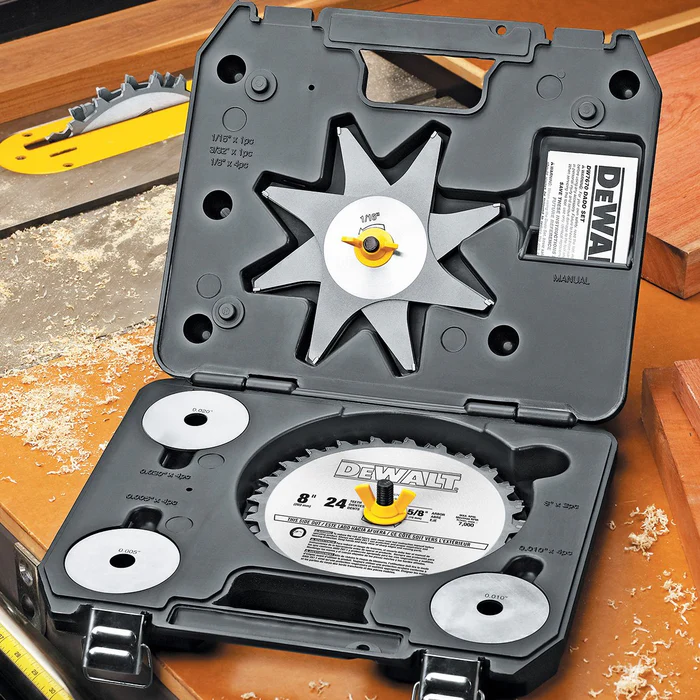
The DEWALT DW7670 is a stacked dado blade set built with precision and finish quality in mind. It features 24-tooth outer blades, four sturdy chippers, and stainless steel shims for accurate width adjustments. The blades are made with premium carbide teeth and come in a heavy-duty storage case for protection.
What makes this set stand out is the laser-cut plates that help reduce vibration and produce flat-bottom cuts with crisp edges. It’s also known for low noise levels, which is a nice bonus in small workshop settings.
Ideal for: Woodworkers who prioritize clean, tear-out-free cuts in plywood, MDF, and hardwood. It’s an excellent middle-ground option between budget and premium sets, and a great fit for most table saws with a 5/8″ arbor.
🧷 How to Install a Dado Blade on a Table Saw
Safety Precautions
Before you even touch your dado blade, make sure your table saw is completely unplugged. This might seem like a no-brainer, but it’s an easy step to overlook—especially when you’re eager to get started. Safety always comes first, and working on a live saw is just not worth the risk.
Next, wear the proper protective gear. Safety glasses are a must, and hearing protection is highly recommended, especially if you’re running a powerful motor. If you’re new to working with dado blades, gloves can help protect your hands while assembling the set—but take them off when the saw is running.
Also, be sure to read your table saw’s manual to confirm that it supports dado blades. Some smaller or portable saws don’t have enough arbor length or motor capacity to safely use these blades. You’ll also need a wide throat plate that can accommodate the dado stack.
Taking a few minutes to set things up safely can save you from costly mistakes—or worse, an injury.
Installation Steps
Installing a dado blade on your table saw is straightforward once you get the hang of it. Follow these steps carefully to ensure a safe and accurate setup:
- Remove the Existing Blade
- Unplug your saw.
- Raise the blade fully, remove the arbor nut and washer, and take off the standard blade.
- Assemble the Desired Dado Stack Width
- Choose the required outer blades, chippers, and shims based on the groove width you want.
- Stack them in the correct order on the arbor. Make sure the teeth face the right direction—just like your standard blade.
- Secure the Dado Set onto the Arbor
- Slide the complete stack onto the arbor.
- Replace the washer and arbor nut, and tighten firmly—but don’t overtighten.
- Adjust the Throat Plate Accordingly
- Replace the regular throat plate with a dado-compatible throat plate.
- It should accommodate the full width of your stack to prevent interference during the cut.
- Test the Setup with Scrap Material
- Raise the blade to the desired height.
- Make a test cut in a piece of scrap wood to confirm the width and depth are correct.
- Adjust your fence or stack as needed before moving on to your actual project.
Taking time to set up your dado blade properly not only ensures precision—it also protects your saw, your project, and most importantly, you.
🦺 Safety Tips When Using Dado Blades

Personal Protective Equipment (PPE)
Using a dado blade requires more than just technical skill—it demands proper safety gear. Always wear ANSI-rated safety glasses to protect your eyes from flying debris, especially when making deep or wide cuts. Since dado blades can produce more noise than standard blades, hearing protection like earmuffs or foam earplugs is strongly recommended.
Avoid loose clothing and tie back long hair to prevent anything from catching in the blade. If you’re setting up or changing the blade, wear cut-resistant gloves—but take them off before turning on the saw to maintain full control.
A small investment in protective equipment can make a big difference in your long-term safety and comfort.
Proper Workpiece Handling
Handling your material correctly is just as important as setting up the blade. When cutting dadoes, especially in long or wide boards, always use push sticks or push blocks to keep your hands at a safe distance from the blade. These tools give you better control without sacrificing safety.
For added precision and protection, use feather boards to hold your workpiece securely against the fence. This helps reduce kickback and ensures a consistent cut depth across the entire groove.
Support long boards with outfeed tables or roller stands so you’re not relying on strength alone to stabilize the workpiece. Consistent pressure and proper alignment help you get cleaner, safer cuts every time.
Regular Maintenance and Inspection

Before each use, take a few moments to inspect your dado blade set. Check that all teeth are intact and free from chips or cracks. Damaged teeth can affect the quality of your cuts and, more importantly, increase the risk of accidents.
Also, look for any buildup of pitch or resin on the blade. A dirty blade generates more heat, which dulls the teeth faster and puts more strain on your saw motor. Use a blade cleaner and brush to maintain sharpness and performance.
Finally, make sure all components—outer blades, chippers, shims—are aligned and properly secured. Loose parts can cause vibration or blade wobble, both of which can compromise your safety and cut quality. A well-maintained blade is not only safer but also delivers far better results.
🔄 Alternatives to Dado Blades
- Using a Router for Dado Cuts
If your table saw doesn’t support dado blades, or you’re working on material that requires more finesse, a router can be a great alternative. With the right bit—typically a straight-cut or spiral upcut bit—you can achieve clean, flat-bottom dadoes in just about any width.
One major advantage of using a router is precision control. You can adjust both depth and width using a fence or edge guide, and some projects even benefit from router jigs for repetitive, consistent dado spacing. Routers also handle plywood particularly well, reducing tear-out on delicate surfaces.
However, routers are generally slower than dado blades and not ideal for bulk cuts. You also need to make multiple passes when cutting wider dadoes, which takes more time. Still, for cabinetry, panels, or working on large sheets, routers offer flexibility and detailed control that blades can’t always match.
- Hand Tool Methods
For the traditionalists out there—or those working without power tools—hand tools are a reliable way to cut dadoes. This method takes more time and patience but offers excellent control and zero noise.
To get started, you’ll need a dado or tenon saw, a chisel, and a mallet. First, use the saw to make the outer scoring cuts. Then, remove the waste between them using a chisel, working along the grain to avoid tear-out. A router plane can help fine-tune the bottom of the groove for a truly flat finish.
Hand tools are great for small projects, fine joinery, or when working in noise-sensitive environments. The main trade-off? Time and skill. This method isn’t ideal for bulk production, but it’s incredibly satisfying and effective for one-off pieces or detailed furniture builds.
Whether you’re working unplugged or just prefer the tactile experience, hand tools are a timeless way to get clean, sturdy dado joints.
Conclusion
Dado blades are essential tools for cutting strong, precise joints in woodworking. Whether you go with a stacked dado set or explore other methods like routers or hand tools, the key is understanding your tools and matching them to your project. The result? Better joints, cleaner builds, and fewer headaches.
FAQs
1. What is the difference between a stacked dado set and a wobble dado blade?
A stacked dado set consists of multiple blades and chippers that stack together to cut a flat-bottom groove with adjustable width. Wobble blades are a single blade mounted at an angle that “wobbles” side to side to create the groove. Stacked sets offer cleaner cuts and better precision, while wobble blades are more affordable and easier to set up but less refined.
2. Can all table saws accommodate dado blades?
Not all table saws are designed for dado blades. Most contractor and cabinet saws support them, especially if they have a long enough arbor and a wide throat plate. However, many compact or jobsite saws do not allow for dado blade use due to size and safety limitations. Always check your saw’s manual before attempting installation.
3. How do I determine the correct width for my dado cut?
Measure the thickness of the mating board that will fit into the dado. Your groove should match that width as closely as possible for a snug fit. Many dado sets allow for fine-tuning the cut using shims and multiple chippers. Always test your setup on scrap material before cutting your final workpiece.
4. Are there specific materials that should not be cut with a dado blade?
Dado blades are ideal for solid wood, plywood, and MDF. However, you should avoid using them on extremely brittle or abrasive materials like hard plastics, laminate countertops, or metal. These can damage the blade or pose safety risks. When in doubt, consult the blade manufacturer’s material compatibility guidelines.
5. What maintenance practices prolong the life of a dado blade set?
Keep your blades clean by removing pitch and resin buildup after use. Store them in a dry, secure case to prevent rust or accidental damage. Inspect the teeth regularly for chips or wear, and sharpen or replace them as needed. Always ensure the blade is tightly assembled and aligned before cutting.

